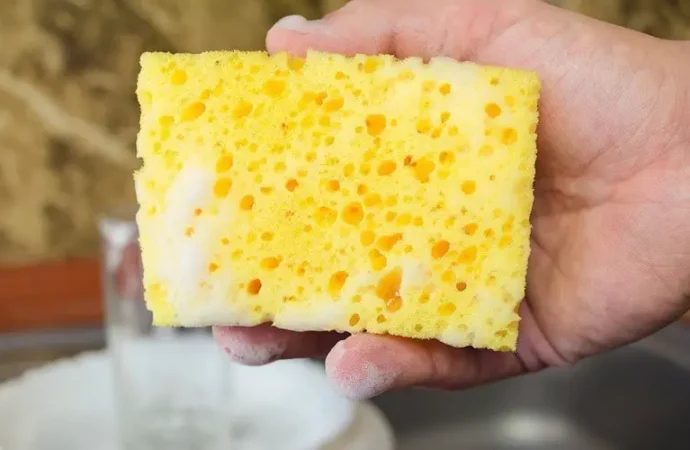Maintaining proper kitchen hygiene is crucial to preventing the spread of illness-causing germs. While washing hands is a common practice, it’s equally important to ensure your kitchen surfaces and cleaning tools, like sponges, remain free from harmful bacteria. Improperly cleaned surfaces can lead to cross-contamination, increasing the risk of foodborne illnesses. From wiping down counters to sanitizing sponges, simple steps can make a significant difference in keeping your kitchen safe. This guide offers essential tips and best practices for maintaining a clean kitchen environment, helping you reduce the spread of harmful germs while preparing food.
Clean Kitchen Surfaces Properly
To maintain a clean and safe kitchen, use hot, soapy water to clean all surfaces after food preparation. Don’t forget to wipe down countertops, appliances, utensils, and cutting boards. Keeping surfaces clean is crucial to avoid cross-contamination, a major contributor to food poisoning. For dishwasher-safe items, ensure to use the high-temperature setting and the drying cycle for thorough sanitation. For large cutting boards and items that cannot be washed in the dishwasher, sanitize them using a mixture of 4 teaspoons of unscented liquid chlorine bleach in 1 quart of water.
Sponge and Dishtowel Safety: Key Dos and Don’ts

Now that we’ve covered how to keep your kitchen surfaces in top condition, it’s essential to focus on your cleaning tools, especially sponges and dishtowels. These items can easily become breeding grounds for harmful bacteria if not properly cleaned or replaced. Let’s dive into some practical dos and don’ts to keep them germ-free and prevent cross-contamination in your kitchen.
Do Clean Sponges Daily
Sponges are a common tool for cleaning dishes, but they can harbour harmful microorganisms. To reduce bacteria buildup, clean your sponges daily by microwaving them for one minute or placing them in the dishwasher with a drying cycle. This method helps kill up to 99% of bacteria, yeasts, and moulds.
Don’t Be a Scrooge: Replace Sponges Regularly
Many of us continue using the same sponges long after they start to smell or show signs of wear. Don’t wait until your sponge falls apart; replace it frequently. If your sponge smells, it’s time to toss it out. Keeping a fresh sponge reduces the risk of spreading harmful bacteria in your kitchen.
Do Start a New Cycle for Dishcloths
Dishcloths and dishtowels can also become breeding grounds for bacteria. Wash them regularly in hot water, and dry them thoroughly using a high heat setting. Frequent laundering of dishcloths will ensure that bacteria do not accumulate over time.
Don’t Use Sponges to Wipe Up Meat Juices
Sponges can spread harmful foodborne pathogens, especially if used to wipe up raw meat juices. Instead of using a sponge, clean up spills from ground beef or poultry with a paper towel or disinfectant wipes. This practice will help prevent the spread of dangerous bacteria.
Do Keep Sponges Dry
After each use, wring out your sponge completely to remove any food debris or moisture. Store it in a dry location. Damp sponges left on countertops or in enclosed spaces like buckets can promote bacteria growth. Make sure to let your sponges dry out properly to reduce the risk of contamination.
Don’t Use Sponges on Countertops
Sponges can contain millions of bacteria, and using them to clean countertops can spread these germs. It’s safer to use paper towels or disinfectant wipes for cleaning kitchen surfaces. This ensures that you don’t transfer bacteria from the sponge to your countertops.
Don’t Ignore Dishcloths
Although dishcloths are less porous than sponges, they can still harbour harmful bacteria. Be sure to wash dishcloths frequently in hot water and dry them on high heat to reduce the risk of bacterial buildup. Consider using different cloths for different purposes—like a separate cloth for hand-washing dishes and another for drying.
The Bottom Line: Kitchen Hygiene Tips to Remember
- Clean your sponges daily by microwaving them for one minute or using the dishwasher with a drying cycle to kill bacteria.
- Replace sponges regularly—if they smell, toss them out immediately.
- Store your sponge in a dry location after each use to prevent bacterial growth.
- Don’t use sponges for cleaning meat juices—opt for paper towels or disinfectant wipes instead.
- Don’t use sponges to clean countertops—use paper towels or wipes to reduce the spread of germs.
- Wash dishcloths regularly in hot water and dry them on high heat.
By following these simple, yet effective tips, you can significantly reduce the risk of illness-causing germs spreading in your kitchen and maintain a safer, cleaner space for food preparation.
 Food Manifest
Food Manifest 















